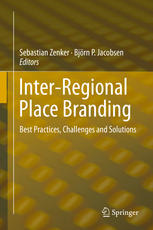Sebastian Zenker, Associate Professor at Copenhagen Business School in Denmark, in this interview talks about place marketing and branding, and shares his experience gained as lecturer in city marketing and as an independent consultant for places and companies, mostly in Germany, Denmark and the Netherlands.
Learn about:
- The nature of place marketing;
- Why doing place branding without something good to communicate is a waste of time;
- The role if city branding in place management;
- How perceptions of places vary across audiences;
- The importance of city brands in the 21st century;
- The benefits and disadvantages of inter-regional place branding;
- Differences in how Dutch, Germans or Danish view and approach place branding;
- How to measure the success of city branding initiatives.
Sebastian, why did you decide to join Copenhagen Business School?
I chose CBS because of its reputation. Quite often universities in well-known places still have a higher reputation than smaller ones in lesser known cities.
In addition, Copenhagen offers an inspiring environment. I work in the knowledge industry and need a stimulating environment. Copenhagen has a high level of excitement and recreation at the same time.
Did the city’s place brand play a role?
Sure. When I asked my wife if she would be interested to move to Copenhagen, I knew I had a much higher chance that she would say “yes” than for other potential places.
Even in a very closed system such as academia (most of the time you do not have a lot of options to choose the location) the place plays an important role.
As researcher, what fascinates you about city brands and place marketing?
I am fascinated by the complexity of the topic and that it is highly interdisciplinary. Researching consumer-insights for cars or other consumer goods can be kind of fun, but places are much more complex in terms of the “product” itself, the different customer groups and the political environment. That is very challenging – something I am always searching for.
Additionally, I am not a big fan of disciplinary boundaries – why should I limit myself to questions only regarding marketing? Why not add a social psychology perspective, or implement something from the field of public administration? These “out-of-the-box” tasks are what keeps me excited about place marketing and branding.
For someone who lives in both worlds – academia and practice (a friend of mine uses the word “pracademics” for us), it is also interesting to see if your thoughts, theories and concepts work out and survive in the “real world”. And I think my clients benefit from having someone on board who has had the time to maybe go a little deeper than the average consultant.
Is place branding a waste of time?
We had an interesting debate among scholars at a conference in San Francisco about that last year. (A city by the way that decided on purpose not to have a branding approach, since they seems to believe it is a waste of time…).
Let me put it like this: for academia, definitely not! As mentioned earlier, place branding and marketing research is a theoretically challenging task, since it requires a lot of “out-of-the-box-thinking”. This gives it a strong academic value.
For practice my answer would be “maybe.” To quote Gregory Ashworth: “you have to fix your place first!”
If you do place branding without something good to communicate, it is a waste of time – you should rather spend the time and money to improve the place itself. Once you changed something, or once there is a real delivery, then you need place branding to get this into the heads of your (potential and existing) place consumers.
How important are city brands in the 21st century?
Places do (more and more) adopt business strategies in their management. Place marketing and branding is one of them. I would agree on the statement that there is a strong competition out there. That does not mean that all places constantly compete with each other. For example, I do not think that the city of Hamburg is competing with cities like Toronto or Barcelona – but for sure with Berlin).
City brands are one additional tool in the toolbox for place management, and as consultant I want to make sure that people know how to use this tool effectively and do not harm themselves or others by trying.
What does it take for place branding initiatives to help residents identify with their city – rather than alienate them?
Residents in particular do have a different perception of “their” place than other (external) customers, especially tourists. A simplified place brand works well with tourists, but residents want to see more complexity in their brand. Once you know a place (and become an internal stakeholder), you know that it can be “rich” and “poor” at the same time – “ugly” and “pretty” too.
If place marketers constantly talk about the city as “rich and pretty”, as a resident you may feel that this is not honest enough to support this picture.
Additionally, a simplified place brand campaign may not fit your identity and therefore you feel excluded. The purpose of a place is to include people; therefore, you also need to address this in your (internal) place branding approach.
I would strongly recommend giving people more freedom to create their own city brand(s). Why does it have to be aligned internally? You cannot ban other opinions anyway (so-called counter-branding approaches) since the city brand does not belong to you.
To quote Shakespeare: “The opposite of love is not hate, but indifference”. As long as people communicate against the “official” brand, they still care about a place – they are still involved. That is something good and shows the quality of that place!
Are there any differences in how Dutch, Germans or Danish view and approach place branding?
After my PhD, I went to the Netherlands since I had the feeling that they are quite advanced in their level of place branding, while Germany (with some exceptions) is still just “learning” how to do it. In Germany, for instance, a lot of focus is on measuring success and return on investment; place managers want to see tangible results of their marketing activities.
In Denmark, the cities and municipalities are much more risk-taking in general – they want to try it out and evaluate later.
How to measure the success of city branding initiatives?
Though question! First, there is no 100% success measurement – and if there would be such an option, it would be way too expensive to do that. Second, for a proper success measurement you need goals you want to achieve.
Only if you define your goals (e.g., more visitors from a particular country) you can measure those goals and see if you had success with your branding approach.
 Your favorite place branding book at the moment?
Your favorite place branding book at the moment?
I liked the German book Städte als Marken – Strategie und Management very much. I also enjoyed Rethinking Place Branding – Comprehensive Brand Development for Cities and Regions.
And I hope people will like our new book, Inter-Regional Place Branding – Best Practices, Challenges and Solutions, which was just published by Springer.
Do you agree with Doug Lansky that DMO’s have to focus less on marketing and more on the management of their destination, to avoid the growing authenticity crisis?
I don’t necessarily share the underlying premise that tourists search for authenticity. They search for a pseudo-authenticity, a Disneyland version of the place. Besides that, I would agree that for DMO’s – as for general place marketing – the statement of Gregory Ashworth is of high importance: “get your place fixed first”.
In “normal” product marketing one task of marketing is to change the product according to the needs of the customers. In place marketing (including destination marketing), this is problematic, since place management (and urban planning in particular) is not included in place marketing.
I wouldn’t go that far, that place marketers are the better place planners – but maybe we should broaden the tasks of place marketing in terms of a mediator and translator between the customer (residents, tourists, etc.) and the producer (urban planners and politicians).
Where do you see the main challenges and opportunities in inter-regional place branding?
Size does matter. Regions (like metropolitan regions, or other regions like the Silicon valley etc.) could complement each other to deliver a better place offer. At the same time, complexity is increasing and – as said before – we need new brand and stakeholder management models to address this complexity.
Your advice to students looking for suitable place (destination, city, country) branding programs?
Unfortunately, there are no real BA or MA programs out there. For CBS students and students from the Erasmus University Rotterdam we are offering a quite interesting course about city marketing.
Additionally, I strongly recommend PhD students to participate in place branding conferences as a way to meet other researcher in the field.
I hope that we will be able to offer some more open courses that cater to scholars and practitioners alike – that is something on my to-do-list!
Thank you, Sebastian.
More about Sebastian Zenker’s work and consulting services here.
Enjoyed our interview with Sebastian Zenker on place marketing and city branding in Germany, Denmark and the Netherlands? Share and spread the word!


